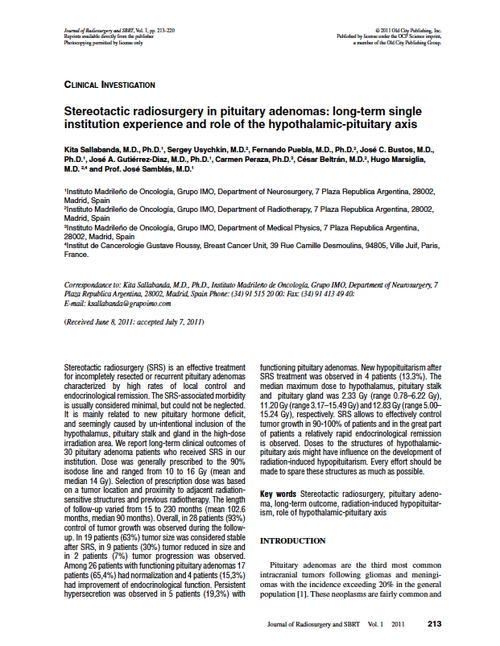- Home
- Journal Contents Downloads
- JRSBRT Downloads
- JRSBRT 1.3, p. 213-220
Product Description
Stereotactic radiosurgery in pituitary adenomas: long-term single institution experience and role of the hypothalamic-pituitary axis
Kita Sallabanda, Sergey Usychkin, Fernando Puebla, José C. Bustos, José A. Gutiérrez-Diaz, Carmen Peraza, César Beltrán, Hugo Marsiglia and Prof. José Samblás
Stereotactic radiosurgery (SRS) is an effective treatment for incompletely resected or recurrent pituitary adenomas characterized by high rates of local control and endocrinological remission. The SRS-associated morbidity is usually considered minimal, but could not be neglected. It is mainly related to new pituitary hormone deficit, and seemingly caused by unintentional inclusion of the hypothalamus, pituitary stalk and gland in the high-dose irradiation area. We report long-term clinical outcomes of 30 pituitary adenoma patients who received SRS in our institution. Dose was generally prescribed to the 90% isodose line and ranged from 10 to 16 Gy (mean and median 14 Gy). Selection of prescription dose was based on a tumor location and proximity to adjacent radiationsensitive structures and previous radiotherapy. The length of follow-up varied from 15 to 230 months (mean 102.6 months, median 90 months). Overall, in 28 patients (93%) control of tumor growth was observed during the followup. In 19 patients (63%) tumor size was considered stable after SRS, in 9 patients (30%) tumor reduced in size and in 2 patients (7%) tumor progression was observed. Among 26 patients with functioning pituitary adenomas 17 patients (65,4%) had normalization and 4 patients (15,3%) had improvement of endocrinological function. Persistent hypersecretion was observed in 5 patients (19,3%) with functioning pituitary adenomas. New hypopituitarism after SRS treatment was observed in 4 patients (13.3%). The median maximum dose to hypothalamus, pituitary stalk and pituitary gland was 2.33 Gy (range 0.78–6.22 Gy), 11.20 Gy (range 3.17–15.49 Gy) and 12.83 Gy (range 5.00– 15.24 Gy), respectively. SRS allows to effectively control tumor growth in 90-100% of patients and in the great part of patients a relatively rapid endocrinological remission is observed. Doses to the structures of hypothalamicpituitary axis might have influence on the development of radiation-induced hypopituitarism. Every effort should be made to spare these structures as much as possible.
Keywords: Stereotactic radiosurgery, pituitary adenoma, long-term outcome, radiation-induced hypopituitarism, role of hypothalamic-pituitary axis
After payment has been processed for your order of a digital copy (PDF) of this article, you will see a download link on your completed order page and also receive an email containing a download link. The links, which will enable you to download one copy of the article, will expire after 24 hours.
 Loading... Please wait...
Loading... Please wait...



